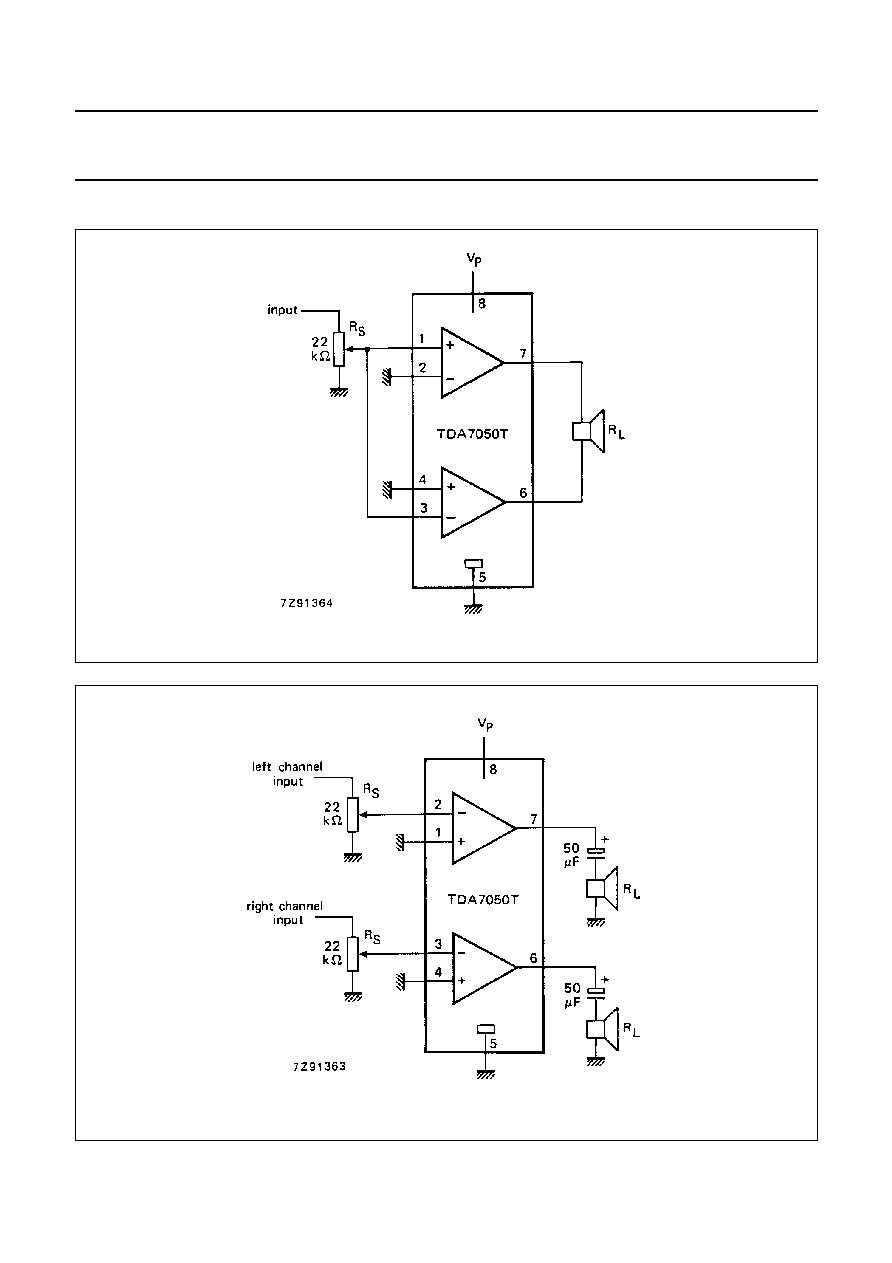 | –≠–ª–µ–∫—Ç—Ä–æ–Ω–Ω—ã–π –∫–æ–º–ø–æ–Ω–µ–Ω—Ç: TDA7050T | –°–∫–∞—á–∞—Ç—å:  PDF PDF  ZIP ZIP |

DATA SHEET
Product specification
File under Integrated Circuits, IC01
July 1994
INTEGRATED CIRCUITS
TDA7050T
Low voltage mono/stereo power
amplifier

July 1994
2
Philips Semiconductors
Product specification
Low voltage mono/stereo power amplifier
TDA7050T
GENERAL DESCRIPTION
The TDA7050T is a low voltage audio amplifier for small radios with headphones (such as watch, pen and pocket radios)
in mono (bridge-tied load) or stereo applications.
Features
∑
Limited to battery supply application only (typ. 3 and 4 V)
∑
Operates with supply voltage down to 1,6 V
∑
No external components required
∑
Very low quiescent current
∑
Fixed integrated gain of 26 dB, floating differential input
∑
Flexibility in use
-
mono BTL as well as stereo
∑
Small dimension of encapsulation (see package design example).
QUICK REFERENCE DATA
PACKAGE OUTLINE
8-lead mini-pack; plastic (SO8; SOT96A); SOT96-1; 1996 July 24.
Supply voltage range
V
P
1,6 to 6,0 V
Total quiescent current (at V
P
= 3 V)
I
tot
typ.
3,2 mA
Bridge tied load application (BTL)
Output power at R
L
= 32
V
P
= 3 V; d
tot
= 10%
P
o
typ.
140 mW
D.C. output offset voltage between the outputs
|
V|
max.
70 mV
Noise output voltage (r.m.s. value)
at f = 1 kHz; R
S
= 5 k
V
no(rms)
typ.
140
µ
V
Stereo application
Output power at R
L
= 32
d
tot
= 10%; V
P
= 3 V
P
o
typ.
35 mW
d
tot
= 10%; V
P
= 4,5 V
P
o
typ.
75 mW
Channel separation at R
S
= 0
; f = 1 kHz
typ.
40 dB
Noise output voltage (r.m.s. value)
at f = 1 kHz; R
S
= 5 k
V
no(rms)
typ.
100
µ
V

July 1994
3
Philips Semiconductors
Product specification
Low voltage mono/stereo power amplifier
TDA7050T
RATINGS
Limiting values in accordance with the Absolute Maximum System (IEC 134)
SO PACKAGE DESIGN EXAMPLE
To achieve the small dimension of the encapsulation the SO package is preferred with only 8 pins. Because a heatsink
is not applicable, the dissipation is limited by the thermal resistance of the 8-pin SO encapsulation until:
Supply voltage
V
P
max.
6 V
Peak output current
I
OM
max.
150 mA
Total power dissipation
see derating curve Fig.1
Storage temperature range
T
stg
-
55 to
+
150
∞
C
Crystal temperature
T
c
max.
100
∞
C
A.C. and d.c. short-circuit duration
at V
P
= 3,0 V (during mishandling)
t
sc
max.
5 s
Fig.1 Power derating curve.
handbook, halfpage
50
0
50
150
400
0
MLB950
100
T ( C)
o
amb
Ptot
(mW)
600
200
T
j max
T
amb
≠
R
th j-a
----------------------------------
100
60
≠
160
----------------------
0.25 W
=
=

July 1994
4
Philips Semiconductors
Product specification
Low voltage mono/stereo power amplifier
TDA7050T
CHARACTERISTICS
V
P
=
3 V; f
=
1 kHz; R
L
=
32
; T
amb
=
25
∞
C; unless otherwise specified
*
Output power is measured directly at the output pins of the IC. It is shown as a function of the supply voltage in Fig.2
(BTL application) and Fig.3 (stereo application).
PARAMETER
SYMBOL
MIN.
TYP.
MAX.
UNIT
Supply
Supply voltage
V
P
1,6
-
6,0
V
Total quiescent current
I
tot
-
3,2
4
mA
Bridge-tied load application (BTL); see Fig.4
Output power
*
V
P
= 3,0 V; d
tot
= 10%
P
o
-
140
-
mW
V
P
= 4,5 V; d
tot
= 10% (R
L
= 64
)
P
o
-
150
-
mW
Voltage gain
G
v
-
32
-
dB
Noise output voltage (r.m.s. value)
R
S
= 5 k
; f = 1 kHz
V
no(rms)
-
140
-
µ
V
R
S
= 0
; f = 500 kHz; B = 5 kHz
V
no(rms)
-
tbf
-
µ
V
D.C. output offset voltage (at R
S
= 5 k
)
|
V|
-
-
70
mV
Input impedance (at R
S
=
)
|Z
i
|
1
-
-
M
Input bias current
I
i
-
40
-
nA
Stereo application; see Fig.5
Output power
*
V
P
= 3,0 V; d
tot
= 10%
P
o
-
35
-
mW
V
P
= 4,5 V; d
tot
= 10%
P
o
-
75
-
mW
Voltage gain
G
v
24.5
26
27.5
dB
Noise output voltage (r.m.s. value)
R
S
= 5 k
; f = 1 kHz
V
no(rms)
-
100
-
µ
V
R
S
= 0
; f = 500 kHz; B = 5 kHz
V
no(rms)
-
tbf
-
µ
V
Channel separation
R
S
= 0
; f = 1 kHz
30
40
-
dB
Input impedance (at R
S
=
)
|Z
i
|
2
-
-
M
Input bias current
I
i
-
20
-
nA

July 1994
5
Philips Semiconductors
Product specification
Low voltage mono/stereo power amplifier
TDA7050T
Fig.2
Output power across the load impedance (R
L
) as a function of supply voltage (V
P
) in BTL application.
Measurements were made at f = 1 kHz; d
tot
= 10%; T
amb
= 25
∞
C.
Fig.3
Output power across the load impedance (R
L
) as a function of supply voltage (V
P
) in stereo application.
Measurements were made at f = 1 kHz; d
tot
= 10%; T
amb
= 25
∞
C.

July 1994
6
Philips Semiconductors
Product specification
Low voltage mono/stereo power amplifier
TDA7050T
APPLICATION INFORMATION
Fig.4 Application diagram (BTL); also used as test circuit.
Fig.5 Application diagram (stereo); also used as test circuit.

July 1994
7
Philips Semiconductors
Product specification
Low voltage mono/stereo power amplifier
TDA7050T
PACKAGE OUTLINE
UNIT
A
max.
A
1
A
2
A
3
b
p
c
D
(1)
E
(2)
(1)
e
H
E
L
L
p
Q
Z
y
w
v
REFERENCES
OUTLINE
VERSION
EUROPEAN
PROJECTION
ISSUE DATE
IEC
JEDEC
EIAJ
mm
inches
1.75
0.25
0.10
1.45
1.25
0.25
0.49
0.36
0.25
0.19
5.0
4.8
4.0
3.8
1.27
6.2
5.8
1.05
0.7
0.6
0.7
0.3
8
0
o
o
0.25
0.1
0.25
DIMENSIONS (inch dimensions are derived from the original mm dimensions)
Notes
1. Plastic or metal protrusions of 0.15 mm maximum per side are not included.
2. Plastic or metal protrusions of 0.25 mm maximum per side are not included.
1.0
0.4
SOT96-1
X
w
M
A
A
1
A
2
b
p
D
H
E
L
p
Q
detail X
E
Z
e
c
L
v
M
A
(A )
3
A
4
5
pin 1 index
1
8
y
076E03S
MS-012AA
0.069
0.010
0.004
0.057
0.049
0.01
0.019
0.014
0.0100
0.0075
0.20
0.19
0.16
0.15
0.050
0.244
0.228
0.028
0.024
0.028
0.012
0.01
0.01
0.041
0.004
0.039
0.016
0
2.5
5 mm
scale
SO8: plastic small outline package; 8 leads; body width 3.9 mm
SOT96-1
95-02-04
97-05-22

July 1994
8
Philips Semiconductors
Product specification
Low voltage mono/stereo power amplifier
TDA7050T
SOLDERING
Introduction
There is no soldering method that is ideal for all IC
packages. Wave soldering is often preferred when
through-hole and surface mounted components are mixed
on one printed-circuit board. However, wave soldering is
not always suitable for surface mounted ICs, or for
printed-circuits with high population densities. In these
situations reflow soldering is often used.
This text gives a very brief insight to a complex technology.
A more in-depth account of soldering ICs can be found in
our
"IC Package Databook" (order code 9398 652 90011).
Reflow soldering
Reflow soldering techniques are suitable for all SO
packages.
Reflow soldering requires solder paste (a suspension of
fine solder particles, flux and binding agent) to be applied
to the printed-circuit board by screen printing, stencilling or
pressure-syringe dispensing before package placement.
Several techniques exist for reflowing; for example,
thermal conduction by heated belt. Dwell times vary
between 50 and 300 seconds depending on heating
method. Typical reflow temperatures range from
215 to 250
∞
C.
Preheating is necessary to dry the paste and evaporate
the binding agent. Preheating duration: 45 minutes at
45
∞
C.
Wave soldering
Wave soldering techniques can be used for all SO
packages if the following conditions are observed:
∑
A double-wave (a turbulent wave with high upward
pressure followed by a smooth laminar wave) soldering
technique should be used.
∑
The longitudinal axis of the package footprint must be
parallel to the solder flow.
∑
The package footprint must incorporate solder thieves at
the downstream end.
During placement and before soldering, the package must
be fixed with a droplet of adhesive. The adhesive can be
applied by screen printing, pin transfer or syringe
dispensing. The package can be soldered after the
adhesive is cured.
Maximum permissible solder temperature is 260
∞
C, and
maximum duration of package immersion in solder is
10 seconds, if cooled to less than 150
∞
C within
6 seconds. Typical dwell time is 4 seconds at 250
∞
C.
A mildly-activated flux will eliminate the need for removal
of corrosive residues in most applications.
Repairing soldered joints
Fix the component by first soldering two diagonally-
opposite end leads. Use only a low voltage soldering iron
(less than 24 V) applied to the flat part of the lead. Contact
time must be limited to 10 seconds at up to 300
∞
C. When
using a dedicated tool, all other leads can be soldered in
one operation within 2 to 5 seconds between
270 and 320
∞
C.

July 1994
9
Philips Semiconductors
Product specification
Low voltage mono/stereo power amplifier
TDA7050T
DEFINITIONS
LIFE SUPPORT APPLICATIONS
These products are not designed for use in life support appliances, devices, or systems where malfunction of these
products can reasonably be expected to result in personal injury. Philips customers using or selling these products for
use in such applications do so at their own risk and agree to fully indemnify Philips for any damages resulting from such
improper use or sale.
Data sheet status
Objective specification
This data sheet contains target or goal specifications for product development.
Preliminary specification
This data sheet contains preliminary data; supplementary data may be published later.
Product specification
This data sheet contains final product specifications.
Limiting values
Limiting values given are in accordance with the Absolute Maximum Rating System (IEC 134). Stress above one or
more of the limiting values may cause permanent damage to the device. These are stress ratings only and operation
of the device at these or at any other conditions above those given in the Characteristics sections of the specification
is not implied. Exposure to limiting values for extended periods may affect device reliability.
Application information
Where application information is given, it is advisory and does not form part of the specification.








